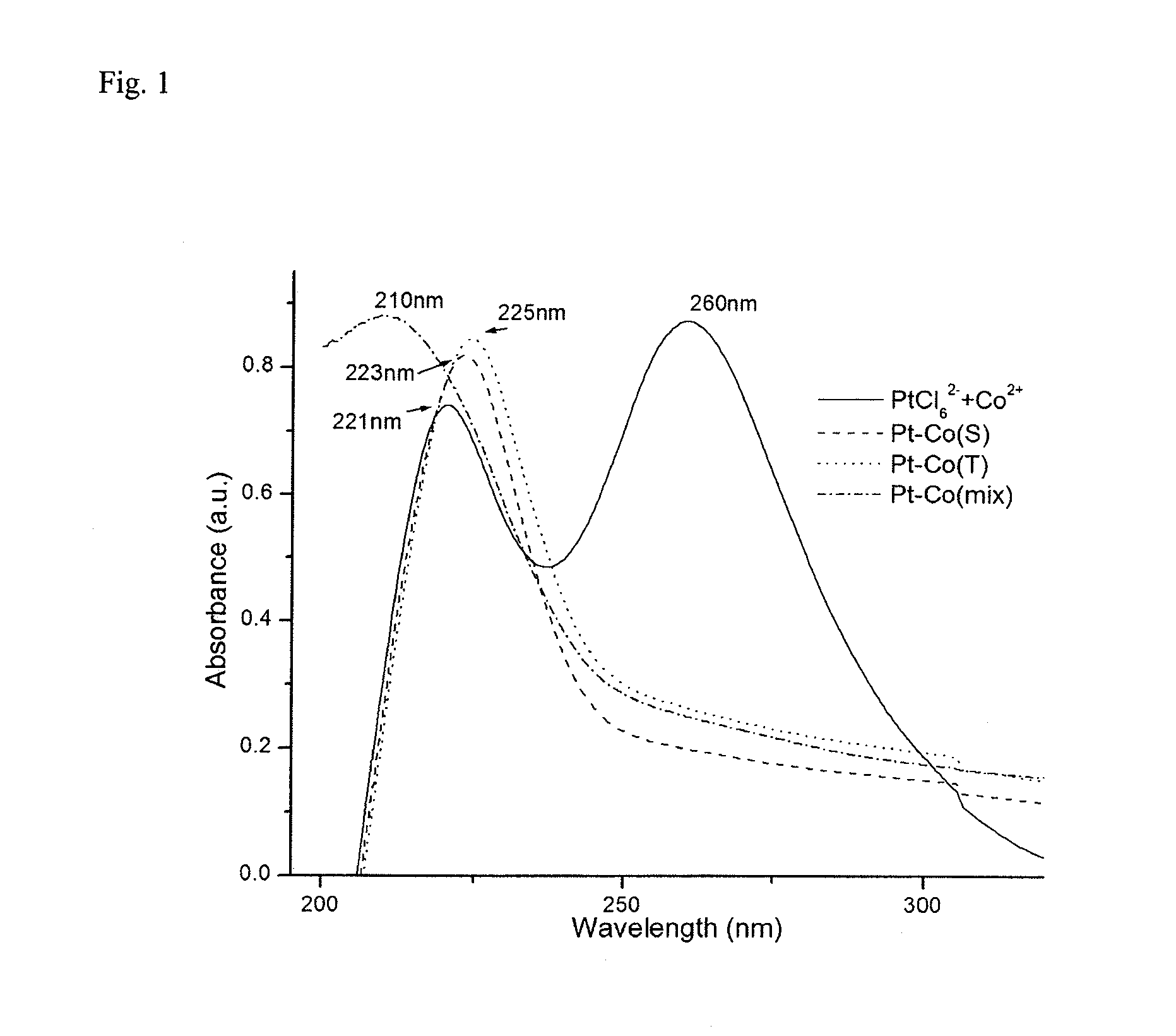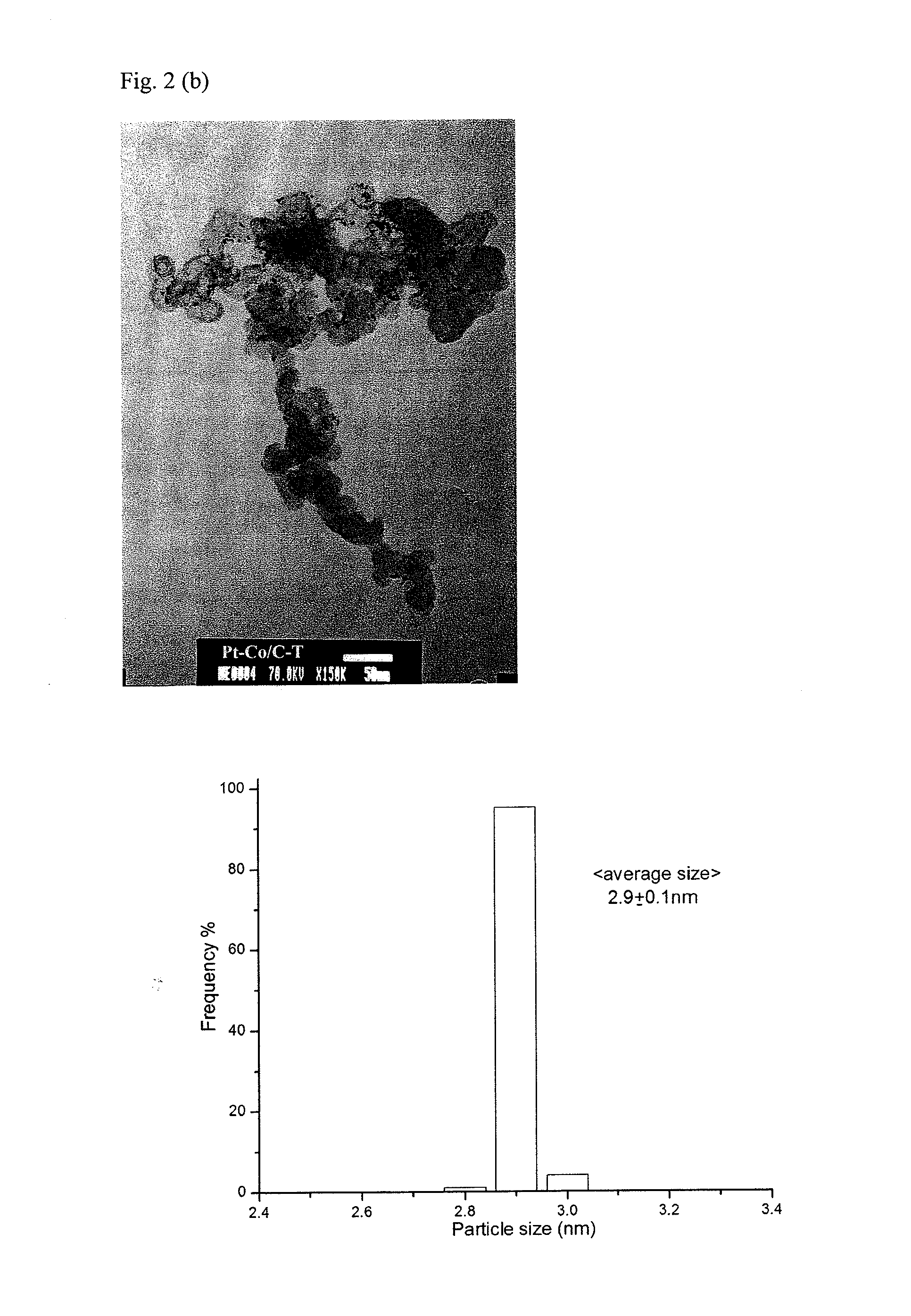Platinum alloy electrocatalyst with enhanced resistance to anion poisoning for low and medium temperature fuel cells
a fuel cell and platinum alloy technology, applied in the direction of metal/metal-oxide/metal-hydroxide catalysts, cell components, physical/chemical process catalysts, etc., can solve the problem of low oxygen reduction reaction (orr) performance at the cathode, the inability to successfully apply pem fuel cells, and the inability to bind with anion poisoning, etc. problem, to achieve the effect of superior electrochemical properties
- Summary
- Abstract
- Description
- Claims
- Application Information
AI Technical Summary
Benefits of technology
Problems solved by technology
Method used
Image
Examples
example 1
Synthesis of Catalysts by a Two Microemulsion Method
[0041]Preparation of Pt—Co nanoparticles utilized a two-microemulsion technique as described previously.34 In this Example, two different methods were used, a simultaneous method and a sequential method. Reverse micellar solutions were prepared using cyclcohexane as the oil phase and sodium dioctyl sulfosuccinate (AOT) as the surfactant in the simultaneous method. The required amounts of 0.25M H2PtCl6 and 0.25M CoCl2 were mixed and injected to a cyclohexane solution containing AOT. The mixtures were then sonicated to form clear and stable micellar solutions. The same procedure was used to prepare the reverse micelle solutions containing 1M aqueous NaBH4 solution as the reducing agent. Then, the two reverse micelle solutions were mixed and vigorously stirred at room temperature for at least 4 hours to ensure the complete reduction of H2PtCl6 as well as CoCl2. The color of the solution changed to dark black from orange due to the for...
example 2
Characterization of Catalysts
[0046]A Hewlett-Packard HP 8453 UV-Vis spectrometer was used to record absorption spectra. The optical path length was 1.0 cm and 0.2M surfactant solutions were used as references.
[0047]Powder X-ray diffraction (XRD) patterns of the catalysts were taken on a Rigaku X-ray Diffractometer equipment with CuKα radiation. The particle size of the dispersed metal crystallites is estimated from the broadening of diffraction peaks using the Scherrer formula.35
[0048]A high-resolution field emission Hitachi 54800 scanning electron microscope (SEM) was used to examine the distribution of Pt alloy particles on Ketjen carbon.
[0049]The morphology and particle size distribution of Pt were examined by a JEOL JEM-1000 general purpose transmission electron microscope (TEM). A small amount of particles was dispersed in isopropanol and then applied on copper mesh with carbon film.
example 3
Electrochemical Measurements
[0050]Electrochemical measurements were conducted in a standard three-compartment electrochemical cell at room temperature using a rotating disk electrode (RDE) setup from Pine Instruments connected to an Autolab (Ecochemie Inc. Model-PGSTAT 30). A glassy carbon disk with geometric area of 0.19625 cm2 was used as the substrate for deposition of catalyst films. All potentials were measured with respect to a sealed hydrogen reference electrode (RHE) made from the same electrolyte used in the ORR experiments. Before deposition of catalyst films, the RDE was first polished with 0.05 micron alumina slurry (Buehler, Lake Bluff, Ill.) and then cleaned with distilled water under sonication. All electrochemical experiments are carried out at room temperatures.
[0051]Catalysts were prepared as described in Example 1. The composition of catalysts was analyzed by VG Elemental Plasmaquad-2 (PQ2) ICP-MS. The results can be seen in Table 1.
[0052]The catalyst inks were pr...
PUM
| Property | Measurement | Unit |
|---|---|---|
| size | aaaaa | aaaaa |
| size | aaaaa | aaaaa |
| size | aaaaa | aaaaa |
Abstract
Description
Claims
Application Information
 Login to View More
Login to View More - R&D
- Intellectual Property
- Life Sciences
- Materials
- Tech Scout
- Unparalleled Data Quality
- Higher Quality Content
- 60% Fewer Hallucinations
Browse by: Latest US Patents, China's latest patents, Technical Efficacy Thesaurus, Application Domain, Technology Topic, Popular Technical Reports.
© 2025 PatSnap. All rights reserved.Legal|Privacy policy|Modern Slavery Act Transparency Statement|Sitemap|About US| Contact US: help@patsnap.com



